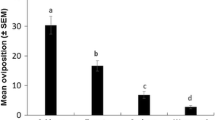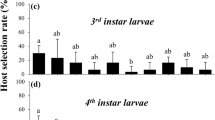Abstract
Sesamia nonagrioides Lefébvre (Lepidoptera: Noctuidae) has a fairly wide range of host plants. The present study tests the egg-laying preference of S. nonagrioides on four potential host plants (maize, sweet and fiber sorghum and johnsongrass) with respect to several life history traits. No-choice and two-choice tests in all possible combinations were conducted. Concerning no-choice tests, significantly higher number of eggs were laid on sweet sorghum (282.5 eggs/female) in relation to the other tested plants. Moreover, viability of eggs that were laid on sweet sorghum was significantly higher in relation to those that were laid on johnsongrass. Longevity of females reared on maize plants was significantly greater compared with the other test plants except johnsongrass. Furthermore, pre-oviposition period of females reared on maize was significantly longer (2.4-fold) compared with that on sweet sorghum and johnsongrass. Similarly post-oviposition period of females reared on maize was significantly longer compared with that on fiber sorghum. On two choice tests significantly fewer eggs were laid on sweet sorghum than on maize. On the other hand, significantly more eggs were laid on sweet sorghum than on fiber sorghum and johnsongrass. We discuss the potential of secondary hosts to be used as trap plants.




Similar content being viewed by others
References
Allison J, Jenner W, Cappuccino N, Mason PG (2007) Oviposition and feeding preference of Acrolepiopsis assectella Zell. (Lep., Acrolepiidae). J Appl Entomol 131:690–697
Allsopp PG, Sallam MS (2001) BSS249 Preparedness for borer incursion. Sesamia incursion management plan Version 1. Bureau of Sugar Experiment Stations Publication, Project Report PR01002
Balagawi S, Vijaysegeram S, Drew RAI, Raghu S (2005) Influence of fruit traits on oviposition preference and offspring performance of Bactrocera tryoni (Froggatt) (Diptera: Tephritidae) on three tomato (Lycopercicon lycopercicum) cultivars. Aust J Entomol 44:97–103
Bengtsson M, Jaastad G, Knudsen G, Kobro S, Bäckman A-C, Pettersson E, Witzgall P (2006) Plant volatiles mediate attraction to host and non-host plant in apple fruit moth, Argyresthia conjugella. Entomol Exp Appl 118:77–85
Calatayud PA, Guenevo H, Ru B, Silvain JF, Frerot B (2007) Temporal patterns of emergence, calling behavior and oviposition period of the maize stem borer, Busseola fusca (Fuller) (Lepidoptera: Noctuidae). Ann Entomol Soc Fr 43:63–68
Commonwealth Institute of Entomology (1991) Distribution maps of pests. Series A (Agricultural), Map no. 11 (2nd rev). Ostrinia nubilalis (Hübner). Commonwealth Agricultural Bureau, London
Dhillon MK, Sharma PD (2003) Studies on biology and behavior of Earias vitella (Lepidoptera: Noctuidae) for mechanisms of resistance in different cotton genotypes. Crop Prot 23:235–241
Fantinou AA, Tsitsipis JA, Karandinos MG (1998) Diapause termination in Sesamia nonagrioides (Lepidoptera: Noctuidae) under laboratory and field conditions. Environ Entomol 27:53–58
Fantinou AA, Perdikis DC, Chatzoglou CS (2003) Development of immature stages of Sesamia nonagrioides (Lepidoptera: Noctuidae) under altering and constant temperatures. Environ Entomol 32:1337–1342
González-Núñez M, Ortego F, Castañera P (2000) Susceptibility of Spanish populations of the corn borers Sesamia nonagrioides (Lepidoptera: Noctuidae) and Ostrinia nubilalis (Lepidoptera: Crambidae) to a Bacillus thuringiensis endotoxin. J Econ Entomol 93:459–463
Konstantopoulou MA, Krokos FD, Mazomenos BE (2002) Chemical Stimuli from corn plants affect host selection and oviposition behavior of Sesamia nonagrioides (Lepidoptera: Noctuidae). J Econ Entomol 95:1289–1293
López C, Eizaguirre M, Albajes R (2003) Courtship and mating behavior of the Mediterranean corn borer, Sesamia nonagrioides (Lepidoptera: Noctuidae). Span J Agric Res 1:43–51
Martin LA, Pullin AS (2004) Host-plant specialization and habitat restriction in an endangered insect, Lycaena dispar batavus (Lepidoptera: Lycaenidae) I. Larval feeding and oviposition preferences. Eur J Entomol 101:51–56
Mayhew PJ (2001) Herbivore host choice and optimal bad motherhood. Trend Ecol Evol 16:165–167
Minitab Inc. (2010) Minitab 16 statistical software. State College
Navrozidis EI, Andreadis SS (2012) Applied agricultural entomology, 1st edn. CopyCity Publish, Thessaloniki (in Greek)
Norris F, Kogan M (2005) Ecology of interaction between weeds and arthropods. Annu Rev Entomol 50:479–503
Poitout S, Bues R (1970) Elevage de plusieurs espèces de Lépidoptères Noctuidae sur milieu artificiel simplifié. Ann Zool Ecol Anim 2:79–91
Renwick JAA (1989) Chemical ecology of oviposition in phytophagous insects. Cell Mol Sci 45:223–228
Renwick JAA, Chew FS (1994) Oviposition behavior in Lepidoptera. Annu Rev Entomol 39:377–400
Schoonhoven LM, van Loon JA, Dicke M (2005) Insect-plant biology, 2nd edn. Oxford University Press, Oxford
Schuster D (2004) Squash as a trap crop to protect tomato from whitefly-vectored tomato yellow leaf curl. Int J Pest Manag 50:281–284
Sharma HC, Franzmann BA (2001) Host plant and oviposition responses of the sorghum midge, Stenidiplosis sorghicola (Coquilett) (Dipt., Cecidomyiidae) towards wild relatives of sorghum. J Appl Entomol 125:109–114
Shelton AM, Badenes-Perez FR (2006) Concepts and applications of trap cropping in pest management. Annu Rev Entomol 51:285–308
Singer MC (1982) Quantification of host preference by manipulation of oviposition behavior in the butterfly Euphydryas editha. Oecologia 52:224–229
Sokal RR, Rohlf FJ (1995) Biometry, 3rd edn. Freeman, New York
Stavrakis GN (1967) Contributions a l’etude des especes nuisibles au mais en Grece du genre Sesamia (Lepidopteres – Noctuidae). Ann Inst Phytopathol Benaki 8:19–22
Thibout E, Auger J, Lecomte C (1982) Host plant chemicals responsible for attraction and oviposition in Acrolepiopsis assectella. In: Visser JH, Minks AK (eds) Proceedings of the 5th international symposium on insect-plant relationships. Kluwer Academic Publications, Dordrecht, pp 107–115
Thiéry D, Moreau J (2005) Relative performance of European grapevine moth (Lobesia botrana) on grapes and other hosts. Oecologia 143:548–557
Thompson JN (1988) Variation in preference and specificity in monophagous and polyphagous swallowtail butterflies. Evolution 42:118–128
Thompson JN, Pellmyr O (1991) Evolution of oviposition behavior and host preference in Lepidoptera. Annu Rev Entomol 36:65–89
Thorsteinson AJ (1960) Host selection in phytophagous insects. Annu Rev Entomol 5:193–218
Zadoks JC, Chang TT, Konzak CF (1974) A decimal code for the growth stages of cereals. Weed Res 14:415–421
Acknowledgments
The authors thank three anonymous reviewers for useful comments. This work was funded by grants from the EU, Proposal No QLRT-2001-01969 (Protecting the Benefits of Bt-toxins from Insect Resistance Development by Monitoring and Management).
Author information
Authors and Affiliations
Corresponding authors
Rights and permissions
About this article
Cite this article
Dimotsiou, O.C., Andreadis, S.S. & Savopoulou-Soultani, M. Egg laying preference of Sesamia nonagrioides (Lepidoptera: Noctuidae) among primary and secondary hosts. Appl Entomol Zool 49, 27–33 (2014). https://doi.org/10.1007/s13355-013-0220-4
Received:
Accepted:
Published:
Issue Date:
DOI: https://doi.org/10.1007/s13355-013-0220-4




